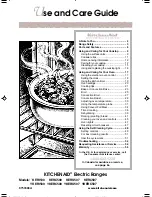
6–52
345 TRANSFORMER PROTECTION SYSTEM – INSTRUCTION MANUAL
S3 PROTECTION
CHAPTER 6: SETPOINTS
Thermal Overload (49)
The thermal overload protection can be applied to prevent damage to the protected
cables, dry transformers, capacitor banks, or even overhead lines. Loads exceeding the
load ratings of the protected equipment can, over time, degrade the insulation, and may in
return lead to short circuit conditions. As the heating of plant equipment such as cables or
transformers is resistive (I
2
R), the generated heat is directly proportional to the square of
the flowing current (I
2
). The relay uses a thermal time characteristic based on current
squared and integrated over time.
The relay will continuously calculate the thermal capacity as a percentage of the total
thermal capacity. The thermal capacity is calculated as follows:
Eq. 12
Where:
θ
(t)
= Thermal capacity (%) at time
t
θ
(t-1)
= Thermal capacity (%) at time
t-1
Δ
t
/
τ
= Time step
Δ
t
divided by the heating/cooling time constant
τ
I
phase
/
I
pickup
= Ratio between the actual load current and the pickup setting
τ
= Heating and cooling time constant, usually provided by the manufacturer.
The heating time constant is used when the squared load/pickup ratio is greater than the
thermal capacity
θ
(t-1)
estimated in the previous time step. Otherwise the formula uses
the cooling time constant.
The time to trip is estimated when the load current exceeds the PKP setting, and the 49
element picks up. At the same time, the thermal capacity will start to increase at a rate
depending on the current amplitude and the prior loading condition of the cable. When the
thermal capacity exceeds the alarm level, the element will generate an alarm signal. The
thermal model alarm can be used as a warning for the start of dangerous overload
conditions, and can prevent unnecessary tripping. When the thermal capacity exceeds the
trip level, the element will generate a trip signal. As per the formula below, the operate time
(time to trip) is determined from when the element picks up until it trips, and depends on
both the measured load over time, and the equipment heating and cooling time constants.
The time to operate is defined by IEC60255-149 standard and based on the initial
equipment state is expressed by the following formulas:
Hot Curve
The time to operate is calculated by the formula below. The formula includes the initial
non-zero thermal capacity of the equipment corresponding to a certain load.
Eq. 13
Where:
T
TRIP
= Time to trip in seconds
θ
0
= Initial thermal capacity
θ
= 1 = Thermal capacitystate set to 100%
τ
= Heating and cooling time constant, usually provided by the manufacturer.
I
phase
/
I
pickup
= Ratio of the actual phase current and the pickup setting.
Cold Curve
Содержание 345
Страница 28: ...1 20 345 TRANSFORMER PROTECTION SYSTEM INSTRUCTION MANUAL SPECIFICATIONS CHAPTER 1 INTRODUCTION ...
Страница 89: ...CHAPTER 3 INTERFACES SOFTWARE SETUP 345 TRANSFORMER PROTECTION SYSTEM INSTRUCTION MANUAL 3 35 ...
Страница 92: ...3 38 345 TRANSFORMER PROTECTION SYSTEM INSTRUCTION MANUAL SOFTWARE SETUP CHAPTER 3 INTERFACES ...
Страница 110: ...4 18 345 TRANSFORMER PROTECTION SYSTEM INSTRUCTION MANUAL A4 TARGET MESSAGES CHAPTER 4 ACTUAL VALUES ...
Страница 116: ...5 6 345 TRANSFORMER PROTECTION SYSTEM INSTRUCTION MANUAL QUICK SETUP SETTINGS CHAPTER 5 QUICK SETUP FRONT CONTROL PANEL ...
Страница 246: ...7 20 345 TRANSFORMER PROTECTION SYSTEM INSTRUCTION MANUAL GENERAL MAINTENANCE CHAPTER 7 MAINTENANCE ...
Страница 254: ...A 8 345 TRANSFORMER PROTECTION SYSTEM INSTRUCTION MANUAL CHANGE NOTES ...
















































